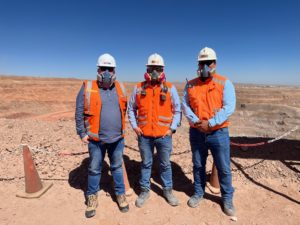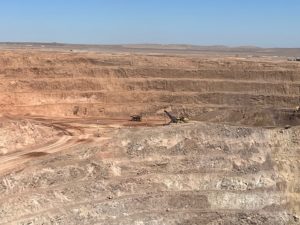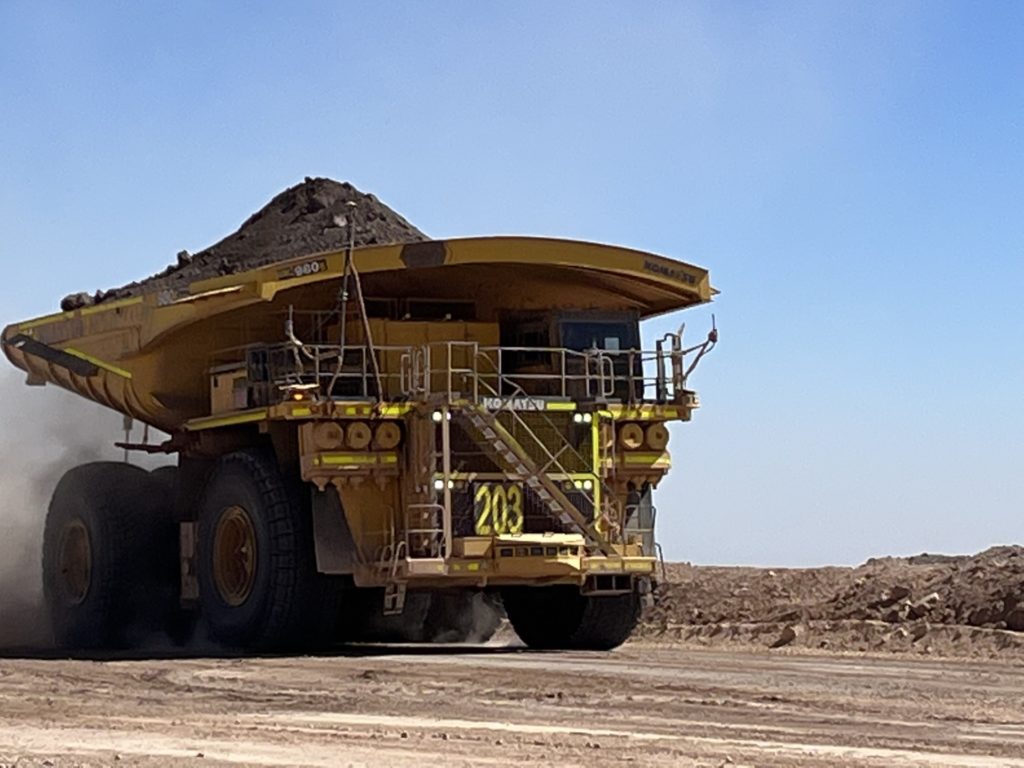Antofagasta Minerals through its Minera Centinela copper mining complex is one of the Tier 1 miners in Chile deploying and proving the latest AHS technology available today – in its case the latest version of Komatsu’s FrontRunner. Right now, the Esperanza Sur pit at Centinela has 16 active 400 ton class Komatsu 980E autonomous trucks – with commissioning of the 17th underway during a recent visit to the operation by IM with Diego Gonzalez Rosas, AHS Mine Shift Manager at Centinela.
IM Editorial Director Paul Moore, Diego Gonzalez Rosas, AHS Mine Shift Manager, Centinela and Pedro Olivares Aviles, AHT Mine Shift Manager, Centinela

The first Esperanza Sur autonomous truck was deployed in December 2021, with an initial plan to deploy 11, which was then increased once that point was reached in a second phase that is now underway. All of the trucks are new and were factory ready for autonomy – the first 11 had everything fitted by Komatsu and were ready to go – the subsequent six require only usual assembly plus fitting of the kits and sensors onsite, which takes about two weeks per truck. The system was described by Gonzalez as plug and play, ready to go once installed and connected.
The operation has one pit patroller working in the mine 24/7, plus the mine chief who monitors the trucks onsite and decides on routes, then the actual autonomous system controller is based in the Centinela IROC in Antofagasta who designates and inputs the routes and route changes into the FrontRunner system. The FrontRunner system is also integrated with the mine FMS, Modular DISPATCH, whose controllers are also based in the IROC. The AHS maintains connectivity using a Nokia LTE private network.
There are several unique things about the autonomous fleet operating at Esperanza Sur – one of which is that the trucks are being loaded by three types of loading tools, namely a Komatsu PC5500 hydraulic excavator, Komatsu P&H 4100 rope shovel and also a Komatsu L-2350 wheel loader, which fill the trucks in 6/7, 3.5 and 6/7 passes respectively. The shovel or wheel loader has a defined loading zone in front of it, within which the operator selects a spotting position for the approaching truck – the truck then takes the most efficient route to that point – during that time, the shovel loads the material so it is ready to load the truck. Spot generation is roughly once every five loads.
So what has the Centinela AHS team identified as the main upside of the autonomous fleet to date? Gonzalez said that of course the first is that the trucks can work more hours per day with no shift changes etc. This is balanced to some extent, however, by the fact that the autonomous truck speed is limited to the manufacturer maximum, whereas in the conventional fleet such as in the main Esperanza pit, the operators are able to slightly exceed that speed. Loaded tonnages are similar. But in addition to operational continuity, AHS brings big savings in terms of reduced damage to the trucks, about a 5% fuel efficiency benefit due to more consistent speed, longer tyre life due to more even tread wear and longer maintenance intervals for major components like engine, axles and wheel motors.
The Esperanza Sur pit has an all autonomous haulage and drilling fleet

On actual traffic management, the minimum distance for all vehicles in the mine is 50 m which is the same in the autonomous pit, and is managed through the mine using Hexagon’s HxGN MineProtect Collision Avoidance System, including on all light vehicles. But the autonomous trucks have an advantage in that they see ahead and project their route for a much greater distance than this – this means that they can communicate with each other to regulate their speed ahead of time, for example, when approaching an intersection, the truck will slow down to allow a truck in front to pass meaning that it doesn’t have to come to a complete stop. This also applies to if a light vehicle for example is on the autonomous route − the autonomous truck will decide if it can just slow down or will need to stop (depending on whether the LV is moving). The LVs have a defined ‘bubble’ that limits the allowed distance between it and other vehicles around it. If the LV is stationary and an obstacle is detected then the pit patroller will make a decision on whether the autonomous truck can proceed or not, once it has stopped. Part of the reason for the autonomous truck not making this decision on its own is that the truck doesn’t yet have sufficient AI to allow for this. This is also down to protocols and sensor-based limitations around restarting a stationary autonomous truck once it is in close proximity to an obstacle.
While Esperanza Sur is now a fully operational AHS mine and not just a trial, it also has the distinction of being Chile’s second fully autonomous haulage fleet after Codelco’s Gaby, but the first in Chile to have a fully autonomous fleet including drills − in Esperanza Sur’s case, two Epiroc Pit Viper PV351s running Epiroc’s autonomous drilling system.
The day after IM’s visit was to be a crucial one for the mine. April 28, 2023, saw the first co-mingling operation of the autonomous trucks with manned trucks. The AHS trucks, up to this date, had been dumping at a stockpile with the ore then rehandled and delivered by conventional truck to the single large primary crushing station between the Esperanza and Esperanza Sur pits. April 28 saw both autonomous and manned trucks unloading into the crusher.
Ultimately, Esperanza Sur is set to have up to 36 autonomous trucks in this phase − but in the future the operation has plans (not yet finalised) to have over 100 autonomous trucks operating at two fully autonomous pits − namely Esperanza Sur, which is a sulphide operation, and the main oxide operation at Centinela − Encuentro Oxides.











